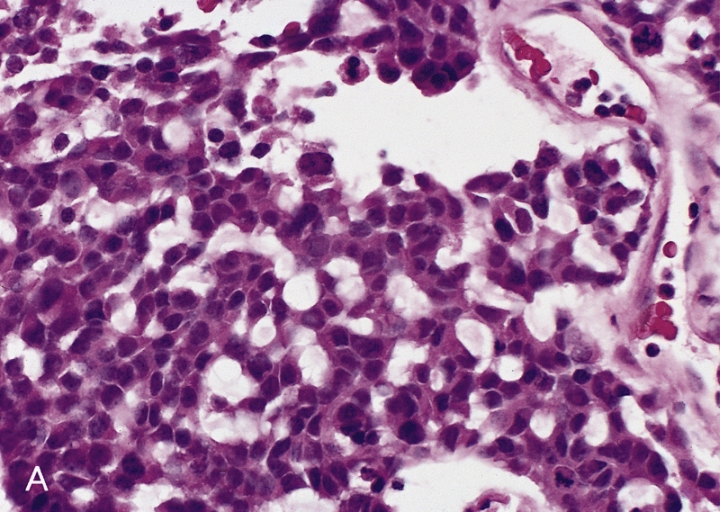|
Hirsutism
Hirsutism is excessive body hair on parts of the body where hair is normally absent or minimal. The word is from early 17th century: from Latin ''hirsutus'' meaning "hairy". It usually refers to a male pattern of hair growth in a female that may be a sign of a more serious medical condition, especially if it develops well after puberty. Cultural stigma against hirsutism can cause much psychological distress and social difficulty. Discrimination based on facial hirsutism often leads to the avoidance of social situations and to symptoms of anxiety and depression. Hirsutism is usually the result of an underlying endocrine imbalance, which may be adrenal, ovarian, or central. It can be caused by increased levels of androgen hormones. The amount and location of the hair is measured by a Ferriman–Gallwey score. It is different from hypertrichosis, which is excessive hair growth anywhere on the body. Treatments may include certain birth control pills, antiandrogens, or ins ... [...More Info...] [...Related Items...] OR: [Wikipedia] [Google] [Baidu] |
Hypertrichosis
Hypertrichosis (sometimes known as werewolf syndrome) is an abnormal amount of hair growth over the body. The two distinct types of hypertrichosis are generalized hypertrichosis, which occurs over the entire body, and localized hypertrichosis, which is restricted to a certain area. Hypertrichosis can be either congenital (present at birth) or acquired later in life. The excess growth of hair occurs in areas of the skin with the exception of androgen-dependent hair of the pubic area, face, and axillary regions. Several circus sideshow performers in the 19th and early 20th centuries, such as Julia Pastrana, had hypertrichosis. Many of them worked as freaks and were promoted as having distinct human and animal traits. Classification Two methods of classification are used for hypertrichosis. One divides them into either generalized versus localized hypertrichosis, while the other divides them into congenital versus acquired. Congenital Congenital forms of hypertrichosis are ... [...More Info...] [...Related Items...] OR: [Wikipedia] [Google] [Baidu] |
Polycystic Ovary Syndrome
Polycystic ovary syndrome, or polycystic ovarian syndrome, (PCOS) is the most common endocrine disorder in women of reproductive age. The name is a misnomer, as not all women with this condition develop cysts on their ovaries. The name originated from the observation of cysts which form on the ovaries of some women with this condition. However, this is not a universal symptom and is not the underlying cause of the disorder. The primary characteristics of PCOS include hyperandrogenism, anovulation, insulin resistance, and neuroendocrinology, neuroendocrine disruption. Women may also experience Abnormal uterine bleeding, irregular menstrual periods, Menorrhagia, heavy periods, hirsutism, excess hair, acne, pelvic pain, infertility, difficulty getting pregnant, and patches of acanthosis nigricans, darker skin. Beyond its reproductive implications, PCOS is increasingly recognized as a multifactorial metabolic condition with significant long-term health consequences, including an ... [...More Info...] [...Related Items...] OR: [Wikipedia] [Google] [Baidu] |
Antiandrogens
Antiandrogens, also known as androgen antagonists or testosterone blockers, are a class of drugs that prevent androgens like testosterone and dihydrotestosterone (DHT) from mediating their biological effects in the body. They act by blocking the androgen receptor (AR) and/or inhibiting or suppressing androgen production. They can be thought of as the functional opposites of AR agonists, for instance androgens and anabolic steroids (AAS) like testosterone, DHT, and nandrolone and selective androgen receptor modulators (SARMs) like enobosarm. Antiandrogens are one of three types of sex hormone antagonists, the others being antiestrogens and antiprogestogens. Antiandrogens are used to treat an assortment of androgen-dependent conditions. In men, antiandrogens are used in the treatment of prostate cancer, enlarged prostate, scalp hair loss, overly high sex drive, unusual and problematic sexual urges, and early puberty. In women, antiandrogens are used to treat acne, sebo ... [...More Info...] [...Related Items...] OR: [Wikipedia] [Google] [Baidu] |
Birth Control Pill
The combined oral contraceptive pill (COCP), often referred to as the birth control pill or colloquially as "the pill", is a type of birth control that is designed to be taken orally by women. It is the oral form of combined hormonal contraception. The pill contains two important hormones: a progestin (a synthetic form of the hormone progestogen / progesterone) and estrogen (usually ethinylestradiol or 17β estradiol). When taken correctly, it alters the menstrual cycle to eliminate ovulation and prevent pregnancy. Combined oral contraceptive pills were first approved for contraceptive use in the United States in 1960, and remain a very popular form of birth control. They are used by more than 100 million women worldwide including about 9 million women in the United States. From 2015 to 2017, 12.6% of women aged 15–49 in the US reported using combined oral contraceptive pills, making it the second most common method of contraception in this age range ( female sterilizati ... [...More Info...] [...Related Items...] OR: [Wikipedia] [Google] [Baidu] |
Congenital Adrenal Hyperplasia Due To 21-hydroxylase Deficiency
Congenital adrenal hyperplasia due to 21-hydroxylase deficiency (CAH) is a genetic disorder characterized by impaired production of cortisol in the adrenal glands. It is classified as an inherited metabolic disorder. CAH is an autosomal recessive condition since it results from inheriting two copies of the faulty '' CYP21A2'' gene responsible for 21-hydroxylase enzyme deficiency. The most common forms of CAH are: ''classical'' form, usually diagnosed at birth, and ''nonclassical'', late onset form, typically diagnosed during childhood or adolescence, although it can also be identified in adulthood when seeking medical help for fertility concerns or other related issues, such as PCOS or menstrual irregularities. Carriers for the alleles of the nonclassical forms may have no symptoms, such form of CAH is sometimes called ''cryptic'' form. Congenital adrenal hyperplasia due to 21-hydroxylase deficiency in all its forms accounts for over 95% of diagnosed cases of all types of conge ... [...More Info...] [...Related Items...] OR: [Wikipedia] [Google] [Baidu] |
Adrenocortical Adenoma
An adrenocortical adenoma or adrenal adenoma is commonly described as a benign neoplasm emerging from the cells that comprise the adrenal cortex. Like most adenomas, the adrenocortical adenoma is considered a benign tumor since the majority of them are non-functioning and asymptomatic. Adrenocortical adenomas are classified as ACTH-independent disorders, and are commonly associated with conditions linked to hyperadrenalism such as Cushing's syndrome ( hypercortisolism) or Conn's syndrome ( hyperaldosteronism), which is also known as primary aldosteronism. In addition, recent case reports further support the affiliation of adrenocortical adenomas with hyperandrogenism or florid hyperandrogenism which can cause hyperandrogenic hirsutism in females. "Cushing's syndrome" differs from the "Cushing's disease" even though both conditions are induced by hypercortisolism. The term "Cushing's disease" refers specifically to "secondary hypercortisolism" classified as "ACTH-dependent Cushi ... [...More Info...] [...Related Items...] OR: [Wikipedia] [Google] [Baidu] |
Cushing's Syndrome
Cushing's syndrome is a collection of signs and symptoms due to prolonged exposure to glucocorticoids such as cortisol. Signs and symptoms may include high blood pressure, abdominal obesity but with thin arms and legs, reddish stretch marks, a round red face due to facial plethora, a fat lump between the shoulders, weak muscles, weak bones, acne, and fragile skin that heals poorly. Women may have more hair and irregular menstruation or loss of menses, with the exact mechanisms of why still unknown. Occasionally there may be changes in mood, headaches, and a chronic feeling of tiredness. Cushing's syndrome is caused by either excessive cortisol-like medication, such as prednisone, or a tumor that either produces or results in the production of excessive cortisol by the adrenal glands. Cases due to a pituitary adenoma are known as Cushing's disease, which is the second most common cause of Cushing's syndrome after medication. A number of other tumors, often referred to ... [...More Info...] [...Related Items...] OR: [Wikipedia] [Google] [Baidu] |
Congenital Adrenal Hyperplasia
Congenital adrenal hyperplasia (CAH) is a group of Genetic disorder#Autosomal recessive, autosomal recessive disorders characterized by impaired cortisol synthesis. It results from the deficiency of one of the five enzymes required for the Biosynthesis, synthesis of cortisol in the adrenal cortex. Most of these disorders involve excessive or deficient production of hormones such as glucocorticoids, mineralocorticoids, or sex steroids, and can alter development of primary sex characteristic, primary or secondary sex characteristics in some affected infants, children, or adults. It is one of the most common autosomal recessive disorders in humans. Types CAH can occur in various forms. The clinical presentation of each form is different and depends to a large extent on the underlying enzyme defect, its precursor retention, and deficient products. Classical forms appear in infancy and nonclassical forms appear in late childhood. The presentation in patients with classic CAH can be fu ... [...More Info...] [...Related Items...] OR: [Wikipedia] [Google] [Baidu] |
Adrenocortical Carcinoma
Adrenocortical carcinoma (ACC) is an aggressive cancer originating in the cortex (steroid hormone-producing tissue) of the adrenal gland. Adrenocortical carcinoma is remarkable for the many hormonal syndromes that can occur in patients with steroid hormone-producing ("functional") tumors, including Cushing's syndrome, Conn syndrome, virilization, and feminization. Adrenocortical carcinoma has often invaded nearby tissues or metastasized to distant organs at the time of diagnosis, and the overall 5-year survival rate is about 50%. Adrenocortical carcinoma is a rare tumor, with incidence of one to two per million population annually. It has a bimodal distribution by age, with cases clustering in children under 5 and in adults 30–40 years old. The widely used angiotensin-II-responsive steroid-producing cell line H295R was originally isolated from a tumor diagnosed as adrenocortical carcinoma. Signs and symptoms Adrenocortical carcinoma may present differently in children ... [...More Info...] [...Related Items...] OR: [Wikipedia] [Google] [Baidu] |
Adrenal Hyperplasia
The adrenal glands (also known as suprarenal glands) are endocrine glands that produce a variety of hormones including adrenaline and the steroids aldosterone and cortisol. They are found above the kidneys. Each gland has an outer cortex which produces steroid hormones and an inner medulla. The adrenal cortex itself is divided into three main zones: the zona glomerulosa, the zona fasciculata and the zona reticularis. The adrenal cortex produces three main types of steroid hormones: mineralocorticoids, glucocorticoids, and androgens. Mineralocorticoids (such as aldosterone) produced in the zona glomerulosa help in the regulation of blood pressure and electrolyte balance. The glucocorticoids cortisol and cortisone are synthesized in the zona fasciculata; their functions include the regulation of metabolism and immune system suppression. The innermost layer of the cortex, the zona reticularis, produces androgens that are converted to fully functional sex hormones in the gonads an ... [...More Info...] [...Related Items...] OR: [Wikipedia] [Google] [Baidu] |
Pituitary Adenoma
Pituitary adenomas are tumors that occur in the pituitary gland. Most pituitary tumors are benign, approximately 35% are invasive and just 0.1% to 0.2% are carcinomas.Pituitary Tumors Treatment (PDQ®)–Health Professional Version NIH National Cancer Institute Pituitary adenomas represent from 10% to 25% of all intracranial neoplasia, neoplasms, with an estimated prevalence, prevalence rate in the general population of approximately 17%. Non-invasive and non-secreting pituitary adenomas are considered to be Benign tumors, benign in the literal as well as the clinical sense, though a 2011 meta-analysis of available research showed that research to either support or refute this assumption was scant and of questionable qua ... [...More Info...] [...Related Items...] OR: [Wikipedia] [Google] [Baidu] |






